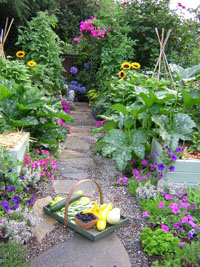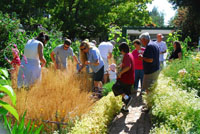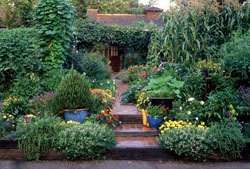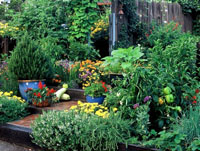Ros Creasy has been one of the trendsetters in edible landscaping for more than 25 years. Her book The Complete Book of Edible Landscaping (Sierra Club Books, 1982) is still one of the bibles on the subject. Ros has been edible landscaping her suburban home in Los Altos, California, giving talks, and helping design edible landscapes for others for more than 25 years. She has seen trends come and go, and believes we are in the middle of a renewed interest in edible landscaping, and growing healthier, local foods. I've known Ros since the 1980s, and it's great to see that her passion for edible landscaping, growing her own food, and teaching kids about nature and gardening hasn't waned. I spent a little time chatting with Ros about edible landscaping then and now. Here's what she had to say.
Q: Although most people think edible landscaping is a new trend, you've been doing it for years, and so have many others. Right?Exactly. People have been growing edible plants near their homes for food and beauty for thousands of years. The ancient Persians, Egyptians, and many Asian cultures integrated edible plants into their pleasure gardens and installed them close to their living space. It was only during the Renaissance that the idea arose to separate utilitarian plants (food) from non-utilitarian flowers. Upper-class people saw growing only flowers near their home as a way to show off their wealth and power. They were so wealthy they could use their land to grow plants simply for pleasure and hide the edibles somewhere else.

Herbs such as parsley and thyme flank the walkway. Raised beds are filled with strawberries, and are bordered by zucchini with their huge, attractive leaves.
Home gardeners for years followed the agricultural model and planted their edibles, both vegetables and fruit trees, in long boring rows and devoid of flowers as they felt, incorrectly, that it was more efficient. Now we know that most beneficial insects need pollen and nectar at some time in their life cycle to reproduce so when you add flowers you actually cut down on pest damage and aid production. Flowers such as alyssum, thyme, cosmos, and marigolds, and natives such as echinacea, aster, and coreopsis, are not just beautiful they help control pests.
And how about getting rid of all those straight lines? When you make your garden beds curved or plant in geometric configurations you'll find they are no harder to maintain then straight lines, and instead of being a ho-hum square, the garden will now have a sense of place, a destination.
Q: How have people's perceptions changed about edible landscaping over the years?When I first started giving talks suggesting integrating flowers into the vegetable garden I was called that "crazy, hippy lady from California." Hey, I wore loafers and lived in the suburbs just like any other middle class person of the time. But a funny thing happened when I first started giving talks. People would come out of the woodwork and tell me about unusual edible plants they would eat. Some would be traditional family foods, some would be regional, wild foods, and others would be ideas people got from visiting other countries. Edible landscaping created a buzz and my books, recipes, and talks grew in popularity.

Ros loves to garden with children. The neighborhood children plant a small patch of hard winter wheat in fall. In spring they harvest it and make bread.
Now when I talk to groups about edible landscaping people almost apologize for not growing more of their own food. Everyone knows what edible landscaping means and that it's a good thing to be doing. It's become part of the gardening vernacular.
Q: How do you win people over into trying edible landscaping?The key is to make it attractive. I looked at what people ate and showed them how to grow it and make it beautiful. Once my neighbors saw that my front yard, filled with vegetables, flowers, fruits and herbs, was more beautiful than any other yard in the neighborhood, they understood the benefits of edible landscaping. They also became more tolerant of my garden being a little messy at times, or having the occasional floating row cover to protect plants from frost. Of course, handing out free tomatoes each summer doesn't hurt either.
I'm not advocating that everyone should grow all their own food, but I'm showing gardeners that growing some of your food is possible without sacrificing beauty.

Ros' front yard shows just how beautiful an edible landscape can be. Tall corn and pole bean plants add a vertical element in contrast to containers filled with rosemary and squash. A hops vine frames the front door.
The kids. It's inspiring to see kids I used to teach about edible landscaping 20 years ago now graduating with degrees in environmental science. Edible landscaping is a way to change a child's view of the world, especially in a suburban community where they normally wouldn't be exposed to growing grains for bread, fruits for juice, or herbs for teas. For me, that's the most important work of edible landscaping--getting kids outside, involved in nature, and learning about the environment and healthy eating.
Q: How have the plants changed in 25 years?There's a much broader selection of edible plants and varieties to choose from now. People may have heard of heirlooms in the 1980s but few knew where to buy seeds and plants to grow. Now they're mainstream. Blue potatoes, purple beans, striped tomatoes, exotic greens all are widely available, where they were novelties 25 years ago. There are also more varieties from around the world available as people travel and try different tastes and flavors. No one would have thought to grow lemongrass for a Thai soup back then.
Q: Where is edible landscaping going in the future?
Herbs and strawberries spill over Ros' walkway where peppers and onions grow with geraniums and marigolds. The flowers are edible, too!
I see edible shrubs and berries as an expanding field. People are waking up to the fact that there are more healthful juices than just orange juice out there. For example, look at the pomegranate juice craze that's happening. There are other berry shrubs such as, sea buckthorn, elderberry and mountain ash (Sorbus) being bred for their berry production and nutritious juice. Often these juices are loaded with anti-oxidants and more nutritious than conventional grape, orange and grapefruit juices most Americans are used to.
Ros Creasy's latest book Recipes from the Garden is due out in January 2008 under Tuttle Press. She's presently revising, The Complete Book of Edible Landscaping, which will be out in spring, 2009.
 Charlie Nardozzi is an award winning, nationally recognized garden writer, speaker, radio, and television personality. He has worked for more than 30 years bringing expert gardening information to home gardeners through radio, television, talks, tours, on-line, and the printed page. Charlie delights in making gardening information simple, easy, fun and accessible to everyone. He's the author of 6 books, has three radio shows in New England and a TV show. He leads Garden Tours around the world and consults with organizations and companies about gardening programs. See more about him at Gardening With Charlie.
Charlie Nardozzi is an award winning, nationally recognized garden writer, speaker, radio, and television personality. He has worked for more than 30 years bringing expert gardening information to home gardeners through radio, television, talks, tours, on-line, and the printed page. Charlie delights in making gardening information simple, easy, fun and accessible to everyone. He's the author of 6 books, has three radio shows in New England and a TV show. He leads Garden Tours around the world and consults with organizations and companies about gardening programs. See more about him at Gardening With Charlie.
 Victory Seed Company has all the seeds you want for your best garden in 2024.
Victory Seed Company has all the seeds you want for your best garden in 2024.
For 25 years, the family-owned Victory Seed Company has provided the highest quality vegetable, herb and flower seeds to families across the country. We are passionate about providing you the best seeds available that give excellent germination, robust plants, and the harvest you want. With a catalog of over a thousand varieties, we have everything, and our prices are the kinds that we'd want to pay. We have hundreds of yesterday's heirloom vegetables, as well as today's award winning hybrid selections. Get to know us by visiting our website and browsing through our online vegetable seed catalog.